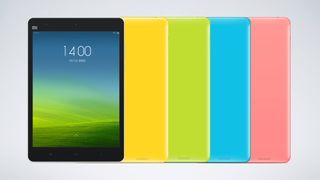Xiaomi Mi Pad is First Nvidia Tegra K1 Tablet, Costs $240
Months after its CES 2014 debut, we're finally seeing Tegra K1 devices in the wild.

Over the last couple of years, the budget tablet market has become a really interesting space. Between the Nexus 7, Amazon's Kindle Fire and numerous other sub $300 offerings, there's never been a better time to invest in a tablet. Now Xiaomi is getting in on the game with a colorful tablet offering of its own. The company has created an Android tablet that closely resembles Apple's iPad mini in terms of form factor.
Dubbed Mi Pad, the tablet packs a 7.9-inch panel with a resolution of 2048 x 1536. Under the hood, you're looking at Nvidia's Tegra K1, the follow on to Tegra 4, which packs a quad-core CPU clocked to 2.2 GHz and Kepler graphics. There's also 2 GB of RAM, a choice of either 16 GB or 64 GB of internal storage, support for microSD expansion up to 128 GB, an 8-megapixel camera in the rear, a 5-megapixel camera up front, WiFi, Bluetooth 4.0, and a 6,700 mAh battery.
Read more: Nvidia Tegra K1 In-Depth: The Power Of An Xbox In A Mobile SoC?
The unveiling was hosted in Beijing, so while Xiaomi was more than happy to talk about Chinese availability (early June), the company didn't offer any information on availability in other regions or markets. Pricewise, the 16 GB model is CN¥1,499, which translates to about $240. The 64 GB model is just a little more at CN¥1,699 or $270. Not bad for the first Tegra K1 tablet.
Follow Jane McEntegart @JaneMcEntegart. Follow us @tomshardware, on Facebook and on Google+.
Stay on the Cutting Edge
Join the experts who read Tom's Hardware for the inside track on enthusiast PC tech news — and have for over 25 years. We'll send breaking news and in-depth reviews of CPUs, GPUs, AI, maker hardware and more straight to your inbox.
-
MANOFKRYPTONAK http://gfxbench.com/result.jsp This tablet is some serious kit. I like the way it looks, it performs well, priced right. I wish it were larger and I wish I knew about the warranty, company, and UI. Although one could just run vanilla Android on here.Reply -
jasonelmore I really hope this comes to the US. If it does, it will force apple to make NAND upgrades cheaper. This tablet only charges $30 for going from 16GB to 64GB of storage. I love it.Reply -
knowom I wish it had HDMI otherwise the rest of the specs are pretty awesome for the price. Makes me curious to see how some of the other Tegra K1 hardware will turn out.Reply -
somebodyspecial Finally? Always announce first then products show up 6 months later just like everyone else. Announce then see stuff months later. It takes 4.5-6 months from the day a SOC shows up at your door before you put a product on the shelf. Google was the fastest every at 4.5mo for the first nexus 7. I don't believe anyone has beat that record yet and most take 5-6 or longer. K1 actually seems to be EARLY as we never saw T4 devices before June (and only shield, everyone else got chips end of july, devices much later).Reply
$270 for 64GB. Nice, just wish it was 1080p for better gaming. This is stupid on a 8in. Why include a K1 if you're not going to consider gaming? It's a Kepler! Many people buying these can't afford a PC and this is basically their first one. Gaming should be a major deal on these little multi-function devices for the poor. I hope they can at least output to TV at 720/1080p so you can run with a gamepad attached & HDMI out. I don't see HDMI in the specs but surely it comes with this? With hi-res and no HDMI it would pretty much be dead as a gaming device IMHO.
Perf from gfx bench shows K1 is pretty impressive. A340 etc have some work cut out for them on the gaming side and NV will only gain more as their desktop chips continue year after year into mobile. Battery life seems to be the only question really left since we know the cpu side already (newer rev of A15, small speedup in IPC +mhz). Mobile gaming is just starting to get REAL :)
I can't wait to see what K1 gaming brings after seeing Halflife 2+Portal for T4 already or any 20nm socs coming soon, which should amp up power massively getting junk to be T4/K1 levels. First we'll get tons of ports (low cost and most of the audience hasn't played before) and then new content for these devices as a larger portion of the market becomes T4 like on the bottom end (allowing everyone to be capable of T4 type stuff). Devs can use the profits from the ports to pay for new IP for mobile with little risk. Hopefully H2/Portal sell well as H2 only sold 12.5mil copies and we're talking a 1.2Billion unit audience on mobile. Portal sold far less, so lots of users to re-sell these to. NV needs to pay for more ports and some original content for K1 (which if started now would take a year or two to come out anyway giving time for sales of shield r2, tablets etc with K1). If the original stuff fails they can easily put it on PC jacked up with details since it would be made for their hardware. Smaller devs can make lots of money now with such a huge audience on mobile (and any K1 games can be ported to PC if they fail on mobile first very quickly), so we'll get more NEW IP instead of call of duty 59, battlefield v50 etc...LOL. -
neon neophyte nice to finally see a company that doesnt gouge the consumer on upgrading the available storage memory.Reply
Most Popular


